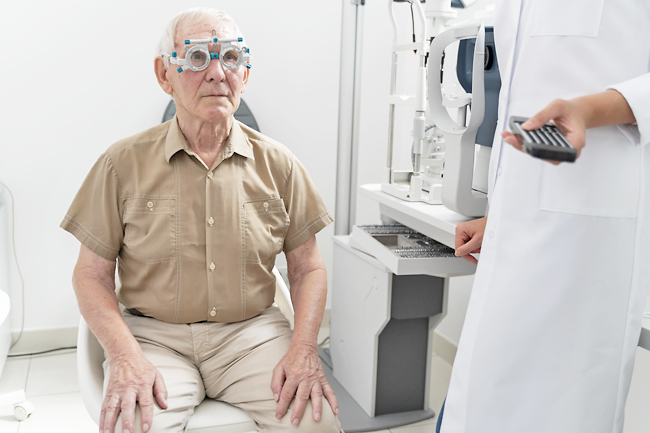Dr Milton Lum
THE STAR – Sight is one of the five senses. Eye conditions are common and can be acute or chronic.
Many adults will have experienced an eye condition in their lives. Some eye conditions do not typically cause vision impairment, but others do.
The common eye conditions that do not typically cause vision impairment include conjunctivitis, dry eye, cyst or stye, benign growth and subconjunctival haemorrhage.
The common eye conditions that can cause vision impairment include cataract, corneal opacity, glaucoma, trachoma, age-related macular degeneration, diabetic or hypertensive retinopathy, and refractive error.
Eye conditions are projected to increase because of various factors like our ageing population, lifestyle and non-communicable diseases.

AFFECTS ALL AGES
Impaired vision affects all ages with the majority being over 50 years of age. The burden of eye conditions and vision impairment is often greater in women, senior citizens, low-income groups, disabled and indigenous people.
Vision impairment impacts the lives of the affected. In young children, it leads to lower levels of educational achievement. In adults, it leads to high depression rates and decreased workforce participation.
The leading causes of vision impairment and blindness are uncorrected refractive errors and cataracts.
Other equally important causes of vision impairment include chronic conditions like diabetes and high blood pressure that cause retinopathy; eye trauma; glaucoma; and age-related macular degeneration.
It was reported in the International Ophthalmology journal in 2014 that half of all cases of childhood blindness in Malaysia were from avoidable causes, with cataracts and retinopathy of prematurity being the main culprits.
Another study reported in Optometry Journal of the American Optometry Association in 2011, that children with low academic achievement were more likely to exhibit problems in visual acuity, ocular motor balance, visual-motor integration and visual analysis skills.
IMPROVING EYE CARE
The World Health Organization’s (WHO) 2019 World Report on Vision provided evidence of the magnitude of eye conditions and vision impairment globally.
It also focussed on effective strategies that address eye care and recommended actions to improve eye care services.
The report, which was directed at governments, civil society, practitioners and researchers, recommended integrated people-centred eye care services that provide a continuum of care based on needs throughout individuals’ lives.
The WHO estimated that at least 2.2 billion people globally have a near or distance vision impairment, of which about one billion could have been prevented.
The projected increase, from 2020 to 2030, in the number of people having age-related macular degeneration and glaucoma were 195.6 to 243.4 million, and 76 to 95.4 million respectively.
RISK FACTORS
The risk factors of vision impairment can be divided into non-modifiable and modifiable.
The non-modifiable factors include age, genetics and ethnicity. For example, the loss of ability to focus on nearby objects (presbyopia) increases with age, and the loss of ability to see distant objects (myopia) is more common in ethnic Chinese.
The modifiable factors are lifestyle-related, such as smoking, nutrition, occupational and recreational activities, and environment-related, including hygiene and access to clean water.
Vision impairment has an enormous global financial burden.
The annual global costs of lost productivity associated with impairment from myopia and presbyopia was estimated in 2019 to be USD244 billion and USD25.4 billion.
‘LOVE YOUR EYES’
World Sight Day is commemorated on October 13. The International Agency for the Prevention of Blindness provided 10 tips for everyone to love their eyes, which are:
1. Follow the 20/20/20 rule to give your eyes screen breaks. When using a screen, look at something 20 feet (six metres) away for 20 seconds every 20 minutes, to avoid eye strain and headaches.
2. Spend time outside. Children should spend at least two hours a day outside. This also helps their eyes develop in a healthy way and helps avoid near-sightedness.
3. Wear sunglasses outside. Make sure your sunglasses offer UVA and UVB protection to prevent radiation from the sun damaging your eyes.
4. Wear prescription glasses if you need them. You should wear your prescription glasses to see clearly and prevent your eyes from having to work harder, which can lead to eye strain and headaches.
5. Check your cosmetics to avoid eye infections. Check the expiry date on eye makeup and replace brushes regularly to prevent bacterial build-up that could cause infections.
6. Exercise regularly. Regular exercise can reduce the risk of conditions like diabetes or high blood pressure, which can affect sight.
7. Eat a healthy diet. A balanced diet ensures you have the vitamins and minerals that are essential for maintaining healthy eyes.
8. Don’t smoke. Smoking increases your risk of serious eye conditions and permanent sight loss.
9. Book an eye test to detect problems before they arise. An eye test can detect an eye condition even before it’s affected your eyesight, so even if you don’t think there’s anything wrong with your eyes, you should book a test to check them.
10. Prioritise your eyes. You need them to last all your life. Put reminders in your calendar to have regular eye checks, which should be once every one to two years.
Vision impairment and blindness have significant and long-lasting effects on every aspect of life, including school and work opportunities, and the ability to access services.
They impact socioeconomic development and life outcomes. So, it is critical to love your eyes as prevention is better than cure.





